 W
WA film crew is a group of people, hired by a production company, for the purpose of producing a film or motion picture. The crew is distinguished from the cast as the cast are understood to be the actors who appear in front of the camera or provide voices for characters in the film. The crew is also separate from the producers as the producers are the ones who own a portion of either the film studio or the film's intellectual property rights. A film crew is divided into different departments, each of which specializes in a specific aspect of the production. Film crew positions have evolved over the years, spurred by technological change, but many traditional jobs date from the early 20th century and are common across jurisdictions and filmmaking cultures.
 W
WStage combat, fight craft or fight choreography is a specialised technique in theatre designed to create the illusion of physical combat without causing harm to the performers. It is employed in live stage plays as well as operatic and ballet productions. With the advent of cinema and television the term has widened to also include the choreography of filmed fighting sequences, as opposed to the earlier live performances on stage. It is closely related to the practice of stunts and is a common field of study for actors. Actors famous for their stage fighting skills frequently have backgrounds in dance, gymnastics or martial arts training.
 W
WAn actor is a person who portrays a character in a performance. The actor performs "in the flesh" in the traditional medium of the theatre or in modern media such as film, radio, and television. The analogous Greek term is ὑποκριτής (hupokritḗs), literally "one who answers". The actor's interpretation of their role—the art of acting—pertains to the role played, whether based on a real person or fictional character. This can also be considered an "actor's role," which was called this due to scrolls being used in the theaters. Interpretation occurs even when the actor is "playing themselves", as in some forms of experimental performance art.
 W
WAn animator is an artist who creates multiple images, known as frames, which give an illusion of movement called animation when displayed in rapid sequence. Animators can work in a variety of fields including film, television, and video games. Animation is closely related to filmmaking and like filmmaking is extremely labor-intensive, which means that most significant works require the collaboration of several animators. The methods of creating the images or frames for an animation piece depend on the animators' artistic styles and their field.
 W
WAn audio engineer helps to produce a recording or a live performance, balancing and adjusting sound sources using equalization, dynamics processing and audio effects, mixing, reproduction, and reinforcement of sound. Audio engineers work on the "technical aspect of recording—the placing of microphones, pre-amp knobs, the setting of levels. The physical recording of any project is done by an engineer ... the nuts and bolts."
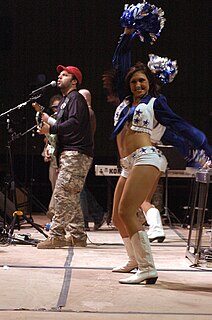 W
WA backup dancer also known as background dancer is a performer who dances with or behind the lead performers in a live musical act or in a music video. Their movements provide a visual symmetry and rhythm to accompany the music.
 W
WA boom operator is a core role in the sound department of a film production, who works with the production sound mixer and utility sound technician. The principal responsibility of the boom operator is microphone placement, usually using a boom pole with a microphone attached to the end, their aim being to hold the microphone as close to the actors or action as possible without allowing the microphone or boom pole to enter the camera's frame.
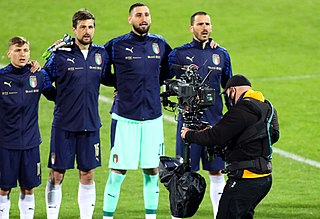 W
WA camera operator, or depending on the context cameraman or camerawoman, is a professional operator of a film camera or video camera as part of a film crew. The term "cameraman" does not imply that a male is performing the task.
 W
WIn the performing arts industry such as theatre, film, or television, a casting is a pre-production process for selecting a certain type of actor, dancer, singer, or extra for a particular role or part in a script, screenplay, or teleplay. This process is typically utilized for a motion picture, television program, documentary, music video, play, or television advertisement, etc. This involvement in a dramatic production, advertisement, and or industrial video is intended for an audience, or studio audience.
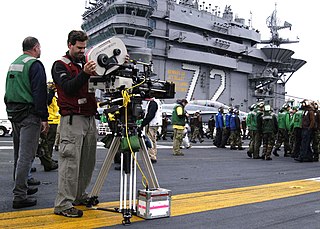 W
WA cinematographer or director of photography is the chief over the camera and light crews working on a film, television production or other live action piece and is responsible for making artistic and technical decisions related to the image. The study and practice of this field is referred to as cinematography.
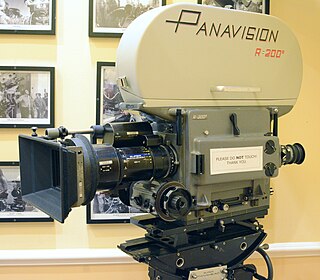 W
WA clapper loader or second assistant camera is part of a film crew whose main functions are that of loading the raw film stock into camera magazines, operating the clapperboard (slate) at the beginning of each take, marking the actors as necessary, and maintaining all records and paperwork for the camera department. The name "clapper loader" tends to be used in the United Kingdom and Commonwealth, while "second assistant camera" tends to be favored in the United States, but the job is essentially the same whichever title is used. The specific responsibilities and division of labor within the department will almost always vary depending on the circumstances of the shoot.
 W
WColor grading is the process of improving the appearance of an image for presentation in different environments on different devices. Various attributes of an image such as contrast, color, saturation, detail, black level, and white point may be enhanced whether for motion pictures, videos, or still images. Color grading and color correction are often used synonymously as terms for this process and can include the generation of artistic color effects through creative blending and compositing of different images. Color grading is generally now performed in a digital process either in a controlled environment such as a color suite, or in any location where a computer can be used in dim lighting.
 W
WCompositing is the process or technique of combining visual elements from separate sources into single images, often to create the illusion that all those elements are parts of the same scene. Live-action shooting for compositing is variously called "chroma key", "blue screen", "green screen" and other names. Today, most, though not all, compositing is achieved through digital image manipulation. Pre-digital compositing techniques, however, go back as far as the trick films of Georges Méliès in the late 19th century, and some are still in use.
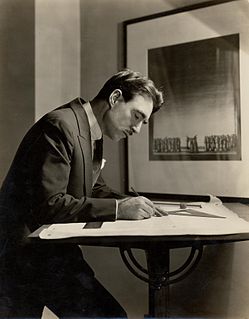 W
WA costume designer is a person who designs costumes for a film, stage production or television show. The role of the costume designer is to create the characters' outfits/costumes and balance the scenes with texture and colour, etc. The costume designer works alongside the director, scenic, lighting designer, sound designer, and other creative personnel. The costume designer may also collaborate with hair stylist, wig master, or makeup artist. In European theatre, the role is different, as the theatre designer usually designs both costume and scenic elements.
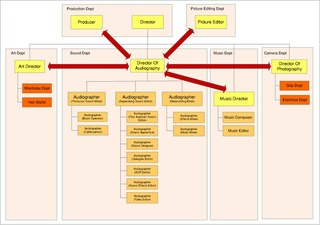 W
WThe director of audiography, (DA) within Indian-style filmmaking, known elsewhere as a Sound Director, is the head of the sound department and the person responsible for planning the audiography and managing the audiographers of a film. The title is not used professionally in most of the world. The role of audiographer and the title "director of audiography" derives from Bollywood-style filmmaking in India, where it is an established title credit. The DA works to carry out the director's vision, identifies the tasks necessary to realize this vision, budgets for those tasks and coordinates all the work from pre-production to post-production whilst keeping an eye on overall sound quality.
 W
WIn cinematography, the dolly grip is a dedicated technician trained to operate the camera dolly. This technician places, levels, and moves the dolly track, then pushes and pulls the dolly and usually a camera operator and camera assistant as riders. If the dolly has a moveable vertical axis, such as a hydraulic arm, then the dolly grip also operates the "boom". If both axes are used simultaneously, this type of dolly shot is known as a compound move.
 W
WA film director controls a film's artistic and dramatic aspects and visualizes the screenplay while guiding the technical crew and actors in the fulfilment of that vision. The director has a key role in choosing the cast members, production design and all the creative aspects of filmmaking. Under European Union law, the director is viewed as the author of the film.
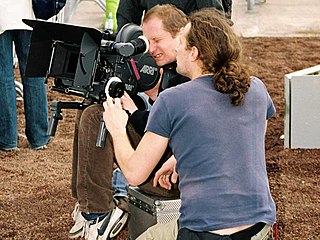 W
WA focus puller or first assistant camera is a member of a film crew's camera department whose primary responsibility is to maintain the camera lens's optical focus on whatever subject or action is being filmed.
 W
WIn film and television crews, the gaffer or chief lighting technician is the head electrician, responsible for the execution of the lighting plan for a production. The term "gaffer" originally related to the moving of overhead equipment to control lighting levels using a gaff. The gaffer's assistant is the best boy electric.
 W
WIn the United States, Canada and the United Kingdom, grips are technicians in the filmmaking and video production industries. They constitute their own department on a film set and are directed by a key grip. Grips have two main functions. The first is to work closely with the camera department to provide camera support, especially if the camera is mounted to a dolly, crane, or in an unusual position, such as the top of a ladder. Some grips may specialize in operating camera dollies or camera cranes. The second main function of grips is to work closely with the electrical department to create lighting set-ups necessary for a shot under the direction of the director of photography.Grips' responsibility is to build and maintain all the equipment that supports cameras. This equipment, which includes tripods, dollies, tracks, jibs, cranes, and static rigs, is constructed of delicate yet heavy duty parts requiring a high level of experience to operate and move. Every scene in a feature film is shot using one or more cameras, each mounted on highly complex, extremely expensive, heavy duty equipment. Grips assemble this equipment according to meticulous specifications and push, pull, mount or hang it from a variety of settings. The equipment can be as basic as a tripod standing on a studio floor, to hazardous operations such as mounting a camera on a 100 ft crane, or hanging it from a helicopter swooping above a mountain range.Good Grips perform a crucial role in ensuring that the artifice of film is maintained, and that camera moves are as seamless as possible. Grips are usually requested by the DoP or the camera operator. Although the work is physically demanding and the hours are long, the work can be very rewarding. Many Grips work on both commercials and features.
 W
WThe light board operator or moving light programmer, is the electrician who operates and/or programs the light board. Depending on the scale and type of production, the board op may be responsible for conventional or automated lighting fixtures, as well as practicals and, in some instances, controlling video as well.
 W
WIn theatre, a lighting designer works with the director, choreographer, set designer, costume designer, and sound designer to create the lighting, atmosphere, and time of day for the production in response to the text, while keeping in mind issues of visibility, safety, and cost. The LD also works closely with the stage manager or show control programming, if show control systems are used in that production. Outside stage lighting, the job of a Lighting Designer can be much more diverse and they can be found working on rock and pop tours, corporate launches, art installations, or lighting effects at sporting events.
 W
WThe location manager is a member of the film crew responsible for finding and securing locations to be used, obtaining all fire, police and other governmental permits, and coordinating the logistics for the production to complete its work. They are also the public face of the production, and responsible for addressing issues that arise due to the production's impact on the community.
 W
WLocation scouting is a vital process in the pre-production stage of filmmaking and commercial photography. Once scriptwriters, producers or directors have decided what general kind of scenery they require for the various parts of their work that is shot outside of the studio, the search for a suitable place or "location" outside the studio begins. Location scouts also look for generally spectacular or interesting locations beforehand, to have a database of locations in case of requests.
 W
WA make-up or makeup artist (MUA) is an artist whose medium is the human body, applying makeup and prosthetics on others for theatre, television, film, fashion, magazines and other similar productions including all aspects of the modeling industry. Awards given for this profession in the entertainment industry include the Academy Award for Best Makeup and Hairstyling, and entertainment industry awards such as the Emmy Awards, and the Golden Globes. In some countries professional licenses are required by agencies in order for them to hire the MUA. Bigger production companies have in-house makeup artists on their payroll although most MUA's generally are freelance and their times remain flexible depending on the projects.
 W
WThe French perchman is equivalent to the U.S. boom operator in film production, also called the sound assistant or boomer, but differs regarding attributions. The perchman is the production sound mixer's assistant and is in charge of the microphone placement, typically using a light and telescopic pole also called a fish pole or boom.
 W
WA production sound mixer, location sound recordist, location sound engineer, or simply sound mixer is the member of a film crew or television crew responsible for recording all sound recording on set during the filmmaking or television production using professional audio equipment, for later inclusion in the finished product, or for reference to be used by the sound designer, sound effects editors, or foley artists. This requires choice and deployment of microphones, choice of recording media, and mixing of audio signals in real time.
 W
WScenic design is the creation of theatrical, as well as film or television scenery. Scenic designers come from a variety of artistic backgrounds, but in recent years, are mostly trained professionals, holding a B.F.A. or M.F.A. degrees in theater arts. Scenic designers design sets and scenery that aim to support the overall artistic goals of the production. There has been a consideration that scenic design is also production design; however, more accurately, it is a part of the visual production of a film or television.
 W
WA special effects supervisor is an individual who works on a commercial, theater, television or film set creating special effects. The supervisor generally is the department head who defers to the film's director and/or producers, and who is in charge of the entire special effects team. Special effects include anything that is manual or mechanically manipulated. This may include the use of mechanized props, special effects makeup, props, scenery, scale models, pyrotechnics and atmospheric effects: creating physical wind, rain, fog, snow, clouds etc.
 W
WA stunt performer, often referred to as a stuntman or stuntwoman, is a trained professional who performs daring acts, often as a career. Stunt performers usually appear in films or on television, as opposed to a daredevil, who performs for a live audience. When they take the place of another actor, they are known as stunt doubles.
 W
WA stunt team is a crew of stunt performers that follow the direction of the stunt coordinator to collectively participate and execute an action sequence for film, television series, commercials, theater or live performance.
 W
WA unit still photographer, or simply still photographer, is a person who creates film stills, still photographic images specifically intended for use in the marketing and publicity of feature films in the motion picture industry and network television productions. Besides creating photographs for the promotion of a film, the still photographer contributes daily to the filming process by creating set stills. With these, the photographer is careful to record all details of cast wardrobe, set appearance and background.